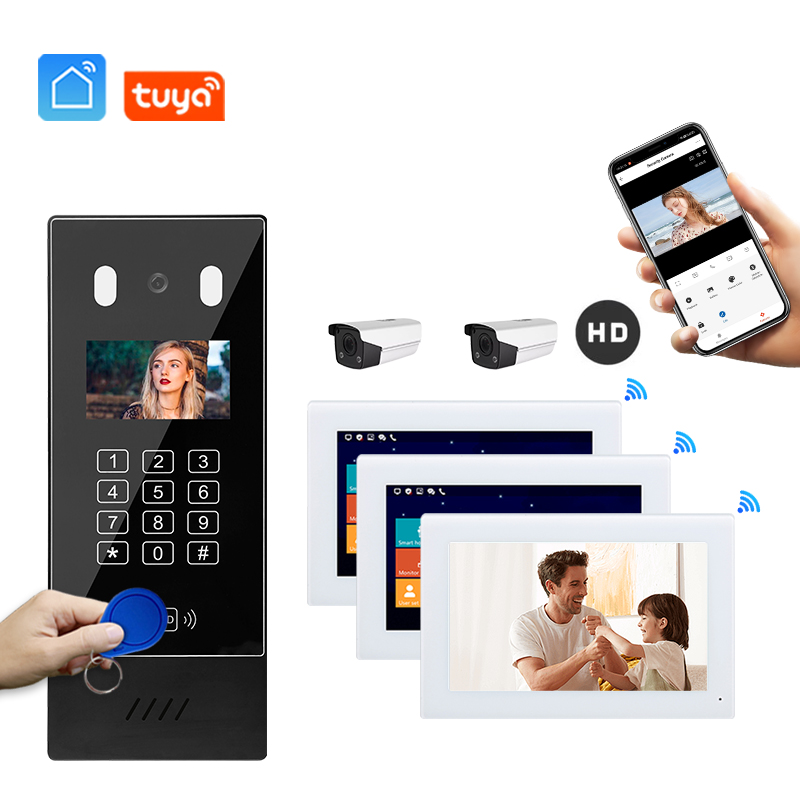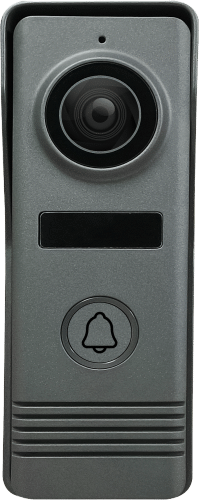Jak podłączyć inteligentny dzwonek do drzwi do Wi-Fi 5 GHz: Kompletny przewodnik konfiguracji
25 czerwca 2025 r
Udostępnij ten artykuł

zrozumienie inteligentnych dzwonków do drzwi i częstotliwości WiFi
Przed zagłębieniem się w techniczne etapy podłączania inteligentnego dzwonka do drzwi do sieci Wi-Fi 5 GHz, kluczowe jest zrozumienie, czym są inteligentne dzwonki do drzwi i jak współdziałają z technologią bezprzewodową.
Czym jest inteligentny dzwonek do drzwi?
Inteligentny dzwonek do drzwi to urządzenie z obsługą Wi-Fi, które pozwala użytkownikom monitorować i komunikować się z odwiedzającymi ich drzwi za pomocą kamery, mikrofonu i głośnika. Łączy się ze smartfonem za pośrednictwem aplikacji i zapewnia powiadomienia w czasie rzeczywistym, kanały wideo i dwukierunkową komunikację.
Kluczowe cechy inteligentnych dzwonków do drzwi:
- HD streaming wideo
- Wykrywanie ruchu
- Dwukierunkowa komunikacja audio
- Nagrywanie wideo w chmurze lub lokalnie
- Zdalny dostęp za pośrednictwem aplikacji mobilnych lub desktopowych
- Integracja z ekosystemami inteligentnego domu, takimi jak Alexa i Google Home
Pasma częstotliwości WiFi: 2,4 GHz vs 5 GHz
Podczas podłączania inteligentnego dzwonka do drzwi do sieci Wi-Fi, wybór pasma częstotliwości może mieć wpływ na wydajność. Oto porównanie:
| Funkcja | 2.wiFi 4 GHz | wiFi 5 GHz |
|---|---|---|
| Zasięg | Większy zasięg, lepsza penetracja ścian | Krótszy zasięg, zmaga się z barierami |
| Prędkość | Wolniej (maks. ~150 Mb/s) | Szybciej (do 1 Gb/s+) |
| Zakłócenia | Więcej zakłóceń ze strony innych urządzeń | Mniej zakłóceń |
| Kompatybilność | Obsługiwany przez większość urządzeń | Nie wszystkie inteligentne dzwonki do drzwi obsługują tę funkcję |
Wiele inteligentnych dzwonków do drzwi dostępnych na rynku obsługuje tylko 2.4GHz ze względu na lepszy zasięg i penetrację ścian, co jest bardziej odpowiednie dla urządzeń zewnętrznych, takich jak dzwonki do drzwi. Jednak nowsze modele z obsługa dwóch pasm może łączyć się z sieciami 5 GHz w celu szybszej transmisji danych i lepszej jakości wideo - jeśli znajduje się w zasięgu.
Dlaczego warto łączyć się z Wi-Fi 5 GHz?
- Szybsze przesyłanie wideo: Idealny do dzwonków wideo o wysokiej rozdzielczości.
- Niższe opóźnienie: Lepsze dla dwukierunkowego dźwięku w czasie rzeczywistym.
- Mniejsze zatłoczenie: Szczególnie przydatne w ruchliwych obszarach z wieloma urządzeniami 2,4 GHz.
Niemniej jednak, przed próbą podłączenia inteligentnego dzwonka do drzwi do sieci 5 GHz należy upewnić się, że obsługuje dwuzakresowe Wi-Fi.
jak sprawdzić, czy inteligentny dzwonek do drzwi obsługuje Wi-Fi 5 GHz?
Ważne jest, aby przed próbą połączenia się ustalić, czy urządzenie obsługuje częstotliwość 5 GHz.
1. Sprawdź specyfikację produktu
Sprawdź pudełko produktu, instrukcję obsługi lub stronę internetową producenta. Jeśli w specyfikacji podano:
- "Obsługuje dwuzakresowe Wi-Fi"
- "Kompatybilny z 2,4 GHz / 5 GHz"
- "IEEE 802.11 a/b/g/n/ac"
W takim przypadku urządzenie jest prawdopodobnie kompatybilne.
2. Korzystanie z aplikacji producenta
Niektóre aplikacje inteligentnego dzwonka do drzwi (takie jak Ring, Eufy lub Arlo) pokażą obsługiwane pasma WiFi podczas konfiguracji. Jeśli 5 GHz nie jest opcją, aplikacja zablokuje wybór.
3. Kontakt z pomocą techniczną lub dostawcą OEM
Jeśli jesteś firmą lub dystrybutorem, który chce kupić lub odsprzedać inteligentne dzwonki do drzwi hurtowo, weryfikacja kompatybilności jest jeszcze ważniejsza. Na przykład, FARHD oferuje konfigurowalne inteligentne systemy domofonowe i dzwonkowe z dwuzakresowymi opcjami WiFi dostępnymi dla klientów ODM/OEM.
Ich zespół badawczo-rozwojowy może pomóc w dostosowaniu modułu WiFi do potrzeb rynku.
| Model | Obsługa WiFi | Uwagi |
|---|---|---|
| FARHD SVDP-4W | 2.tylko 4 GHz | Idealny do domów jednorodzinnych |
| FARHD DualBand+ | 2.4GHz & 5GHz | Wersja OEM/ODM z dwuzakresowym WiFi |

kroki podłączenia inteligentnego dzwonka do drzwi do sieci Wi-Fi 5 GHz
Jeśli inteligentny dzwonek do drzwi obsługuje częstotliwość 5 GHz, wykonaj poniższe czynności, aby go podłączyć:
Krok 1: Przygotowanie routera
- Zaloguj się do panelu administracyjnego routera WiFi (zwykle 192.168.1.1 lub 192.168.0.1).
- Upewnij się, że pasmo 5 GHz jest włączone.
- Daj każdemu zespołowi oddzielny identyfikator SSID (np. HomeWiFi_2.4 i HomeWiFi_5G), aby uniknąć nieporozumień.
- Ustaw Hasło WiFi dla obu pasm.
Krok 2: Umieść dzwonek w zasięgu
5 GHz ma krótszy zasięg, więc inteligentny dzwonek do drzwi musi być w odległości 10-20 stóp routera z minimalną przeszkodą na ścianie.
Wskazówki:
- Należy unikać umieszczania routera za grubymi betonowymi lub metalowymi ścianami.
- W razie potrzeby użyj przedłużacza Wi-Fi obsługującego częstotliwość 5 GHz.
Krok 3: Zresetuj dzwonek do drzwi (jeśli został wcześniej skonfigurowany)
- Przytrzymaj przycisk resetowania (zwykle z tyłu lub na dole) przez 10-15 sekund, aż dioda LED zacznie migać.
- Powoduje to przełączenie urządzenia w tryb Tryb parowania WiFi.
Krok 4: Użyj aplikacji do połączenia
- Pobierz aplikację producenta (np. FARHD App, Ring, Arlo itp.).
- Rozpocznij proces konfiguracji i wybierz sSID Wi-Fi 5 GHz.
- Wprowadź hasło.
- Poczekaj, aż urządzenie się połączy. Powinieneś zobaczyć potwierdzenie powodzenia.
Jeśli aplikacja nie pokazuje identyfikatora SSID 5 GHz, dzwonek do drzwi prawdopodobnie go nie obsługuje.
Krok 5: Przetestuj połączenie
- Użyj aplikacji, aby oglądać transmisję na żywo.
- Sprawdź opóźnienia, buforowanie lub problemy z dźwiękiem.
- Jeśli wydajność jest niska, spróbuj przełączyć się na częstotliwość 2,4 GHz lub użyj dwuzakresowego systemu mesh.
⚠️ Rozwiązywanie typowych problemów z połączeniem Wi-Fi 5 GHz
Nawet w przypadku kompatybilnego sprzętu mogą wystąpić problemy. Oto jak je rozwiązać:
| Problem | Przyczyna | Rozwiązanie |
|---|---|---|
| identyfikator SSID 5 GHz nie jest widoczny | Ustawienia routera lub odległość | Zmień nazwę SSID, przybliż dzwonek do drzwi |
| Połączenie nie powiodło się | Nieprawidłowe hasło lub zakłócenia | Wprowadź ponownie hasło, uruchom ponownie router |
| Aplikacja nie pokazuje opcji 5 GHz | Dzwonek do drzwi nie jest dwuzakresowy | Potwierdź specyfikację modelu |
| Opóźnienie wideo/audio | Słaba siła sygnału | Zmiana położenia routera lub użycie przedłużacza |
Zaawansowane wskazówki:
- Użyj kanał 36 lub 40 w paśmie 5 GHz - niektóre urządzenia nie obsługują wyższych kanałów (149+).
- Wyłącz DFS (Dynamic Frequency Selection), jeśli powoduje zerwanie połączenia.

kupujący B2B: Wybór inteligentnych dzwonków do drzwi kompatybilnych z 5 GHz
Jeśli jesteś dystrybutor, instalator inteligentnego domu lub nabywca OEMkompatybilność z częstotliwością 5 GHz staje się kluczowym wyróżnikiem na rynkach premium.
Na co zwrócić uwagę:
- Obsługa dwuzakresowego Wi-Fi (2,4 GHz + 5 GHz)
- Obsługa WiFi6 lub IEEE 802.11ac
- Kompatybilność z aplikacjami mobilnymi
- Aktualizacje oprogramowania sprzętowego OTA
- Opcje przechowywania danych w chmurze i/lub lokalnie
- Dostępność dostosowań OEM/ODM
Zalecany producent w Chinach: FARHD
FARHD jest zaufanym dostawcą OEM/ODM z ponad 25-letnim doświadczeniem w produkcji inteligentnych dzwonków wideo. Oferuje:
- Dwuzakresowe moduły WiFi dostępne do personalizacji
- Pełny rozwój od LCD do produktu końcowego
- Produkcja z certyfikatem ISO 9001
- Zaawansowane linie SMT i zautomatyzowany montaż
- Wsparcie dla marek własnych i integracji aplikacji
Ich usługi OEM/ODM są idealnym rozwiązaniem dla firm, które chcą oferować pod swoją marką wysokiej jakości dzwonki do drzwi z obsługą częstotliwości 5 GHz.
🔁 Różnica między 2,4 GHz a 5 GHz w rzeczywistych zastosowaniach
| Funkcja | 2.4GHz | 5 GHz |
|---|---|---|
| 1. Bezprzewodowy wideodomofon SKYNEX (dostępny OEM/ODM) | Daleki zasięg, przez ściany | Wysoka prędkość i krótki zasięg |
| Typowa prędkość | 50-150 Mb/s | 200-900+ Mb/s |
| Opóźnienie | Wyższy | Niższy |
| Obsługa urządzeń | Prawie wszystkie urządzenia | Tylko nowsze urządzenia |
| Niezawodność | Więcej zakłóceń | Czystszy sygnał |
Zalecenie: Użyj 2.4GHz jeśli dzwonek do drzwi znajduje się daleko od routera lub między nimi są ściany. Użyj 5 GHz jeśli jest blisko i chcesz uzyskać szybszą wydajność.
powiązane zasoby
- Poznaj FARHD katalog produktów inteligentnego dzwonka do drzwi
- Dowiedz się więcej o FARHD możliwościach OEM/ODM Skynex
- Skontaktuj się z FARHD w sprawie zamówień B2B za pośrednictwem strony kontaktową

najczęściej zadawane pytania (FAQ)
P1: Czy mogę zmusić dzwonek do drzwi działający tylko na częstotliwości 2,4 GHz do połączenia się z częstotliwością 5 GHz?
O: Jeśli sprzęt nie obsługuje częstotliwości 5 GHz, po prostu nie wykryje sieci. Potrzebne będzie urządzenie obsługujące dwa pasma.
P2: Skąd mam wiedzieć, czy jestem połączony z częstotliwością 5 GHz?
O: Podczas konfiguracji sprawdź nazwę sieci Wi-Fi (SSID). Jeśli nazwa pasma 5 GHz jest inna (np. HomeWiFi_5G), wybrana sieć to potwierdzi.
P3: Czy mogę używać systemów mesh WiFi z inteligentnymi dzwonkami do drzwi?
O: Tak, dwuzakresowe systemy mesh, takie jak Google Nest WiFi lub eero, zapewniają stały zasięg i umożliwiają płynne przełączanie między częstotliwościami 2,4 GHz i 5 GHz.
P4: Czy częstotliwość 5 GHz działa lepiej w przypadku strumieniowania wideo?
O: Tak, częstotliwość 5 GHz oferuje wyższą przepustowość, co zmniejsza buforowanie i poprawia jakość wideo - ale tylko wtedy, gdy siła sygnału jest wystarczająca.
P5: Jaki jest najlepszy inteligentny dzwonek do drzwi z obsługą częstotliwości 5 GHz dla zamówień masowych?
O: W przypadku zamówień hurtowych lub dostosowywania OEM/ODM, FARHD to czołowy producent oferujący elastyczne, dwuzakresowe inteligentne rozwiązania wideodomofonowe dostosowane do potrzeb biznesowych.
Tytuł: Jak podłączyć inteligentny dzwonek do drzwi do Wi-Fi 5 GHz: Kompletny przewodnik konfiguracji
zrozumienie inteligentnych dzwonków do drzwi i częstotliwości WiFi
Przed zagłębieniem się w techniczne etapy podłączania inteligentnego dzwonka do drzwi do sieci Wi-Fi 5 GHz, kluczowe jest zrozumienie, czym są inteligentne dzwonki do drzwi i jak współdziałają z technologią bezprzewodową.
Czym jest inteligentny dzwonek do drzwi?
Inteligentny dzwonek do drzwi to urządzenie z obsługą Wi-Fi, które pozwala użytkownikom monitorować i komunikować się z odwiedzającymi ich drzwi za pomocą kamery, mikrofonu i głośnika. Łączy się ze smartfonem za pośrednictwem aplikacji i zapewnia powiadomienia w czasie rzeczywistym, kanały wideo i dwukierunkową komunikację.
Kluczowe cechy inteligentnych dzwonków do drzwi:
- Strumieniowa transmisja wideo HD
- Wykrywanie ruchu
- Dwukierunkowa komunikacja audio
- Nagrywanie wideo w chmurze lub lokalnie
- Zdalny dostęp za pośrednictwem aplikacji mobilnych lub desktopowych
- Integracja z ekosystemami inteligentnego domu, takimi jak Alexa i Google Home
Pasma częstotliwości WiFi: 2,4 GHz vs 5 GHz
Podczas podłączania inteligentnego dzwonka do drzwi do sieci Wi-Fi, wybór pasma częstotliwości może mieć wpływ na wydajność. Oto porównanie:
| Funkcja | 2.wiFi 4 GHz | wiFi 5 GHz |
|---|---|---|
| Zasięg | Większy zasięg, lepsza penetracja ścian | Krótszy zasięg, zmaga się z barierami |
| Prędkość | Wolniej (maks. ~150 Mb/s) | Szybciej (do 1 Gb/s+) |
| Zakłócenia | Więcej zakłóceń ze strony innych urządzeń | Mniej zakłóceń |
| Kompatybilność | Obsługiwany przez większość urządzeń | Nie wszystkie inteligentne dzwonki do drzwi obsługują tę funkcję |
Wiele inteligentnych dzwonków do drzwi dostępnych na rynku obsługuje tylko 2.4GHz ze względu na lepszy zasięg i penetrację ścian, co jest bardziej odpowiednie dla urządzeń zewnętrznych, takich jak dzwonki do drzwi. Jednak nowsze modele z obsługa dwóch pasm może łączyć się z sieciami 5 GHz w celu szybszej transmisji danych i lepszej jakości wideo - jeśli znajduje się w zasięgu.
Dlaczego warto łączyć się z Wi-Fi 5 GHz?
- Szybsze przesyłanie wideo: Idealny do dzwonków wideo o wysokiej rozdzielczości.
- Niższe opóźnienie: Lepsze dla dwukierunkowego dźwięku w czasie rzeczywistym.
- Mniejsze zatłoczenie: Szczególnie przydatne w ruchliwych obszarach z wieloma urządzeniami 2,4 GHz.
Niemniej jednak, przed próbą podłączenia inteligentnego dzwonka do drzwi do sieci 5 GHz należy upewnić się, że obsługuje dwuzakresowe Wi-Fi.
jak sprawdzić, czy inteligentny dzwonek do drzwi obsługuje Wi-Fi 5 GHz?
Ważne jest, aby przed próbą połączenia się ustalić, czy urządzenie obsługuje częstotliwość 5 GHz.
1. Sprawdź specyfikację produktu
Sprawdź pudełko produktu, instrukcję obsługi lub stronę internetową producenta. Jeśli w specyfikacji podano:
- "Obsługuje dwuzakresowe Wi-Fi"
- "Kompatybilny z 2,4 GHz / 5 GHz"
- "IEEE 802.11 a/b/g/n/ac"
W takim przypadku urządzenie jest prawdopodobnie kompatybilne.
2. Korzystanie z aplikacji producenta
Niektóre aplikacje inteligentnego dzwonka do drzwi (takie jak Ring, Eufy lub Arlo) pokażą obsługiwane pasma WiFi podczas konfiguracji. Jeśli 5 GHz nie jest opcją, aplikacja zablokuje wybór.
3. Kontakt z pomocą techniczną lub dostawcą OEM
Jeśli jesteś firmą lub dystrybutorem, który chce kupić lub odsprzedać inteligentne dzwonki do drzwi hurtowo, weryfikacja kompatybilności jest jeszcze ważniejsza. Na przykład, FARHD oferuje konfigurowalne inteligentne systemy domofonowe i dzwonkowe z dwuzakresowymi opcjami WiFi dostępnymi dla klientów ODM/OEM.
Ich zespół badawczo-rozwojowy może pomóc w dostosowaniu modułu WiFi do potrzeb rynku.
| Model | Obsługa WiFi | Uwagi |
|---|---|---|
| FARHD SVDP-4W | 2.tylko 4 GHz | Idealny do domów jednorodzinnych |
| FARHD DualBand+ | 2.4GHz & 5GHz | Wersja OEM/ODM z dwuzakresowym WiFi |
kroki podłączenia inteligentnego dzwonka do drzwi do sieci Wi-Fi 5 GHz
Jeśli inteligentny dzwonek do drzwi obsługuje częstotliwość 5 GHz, wykonaj poniższe czynności, aby go podłączyć:
Krok 1: Przygotowanie routera
- Zaloguj się do panelu administracyjnego routera WiFi (zwykle 192.168.1.1 lub 192.168.0.1).
- Upewnij się, że pasmo 5 GHz jest włączone.
- Daj każdemu zespołowi oddzielny identyfikator SSID (np. HomeWiFi_2.4 i HomeWiFi_5G), aby uniknąć nieporozumień.
- Ustaw Hasło WiFi dla obu pasm.
Krok 2: Umieść dzwonek w zasięgu
5 GHz ma krótszy zasięg, więc inteligentny dzwonek do drzwi musi być w odległości 10-20 stóp routera z minimalną przeszkodą na ścianie.
Wskazówki:
- Należy unikać umieszczania routera za grubymi betonowymi lub metalowymi ścianami.
- W razie potrzeby użyj przedłużacza Wi-Fi obsługującego częstotliwość 5 GHz.
Krok 3: Zresetuj dzwonek do drzwi (jeśli został wcześniej skonfigurowany)
- Przytrzymaj przycisk resetowania (zwykle z tyłu lub na dole) przez 10-15 sekund, aż dioda LED zacznie migać.
- Powoduje to przełączenie urządzenia w tryb Tryb parowania WiFi.
Krok 4: Użyj aplikacji do połączenia
- Pobierz aplikację producenta (np. FARHD App, Ring, Arlo itp.).
- Rozpocznij proces konfiguracji i wybierz sSID Wi-Fi 5 GHz.
- Wprowadź hasło.
- Poczekaj, aż urządzenie się połączy. Powinieneś zobaczyć potwierdzenie powodzenia.
Jeśli aplikacja nie pokazuje identyfikatora SSID 5 GHz, dzwonek do drzwi prawdopodobnie go nie obsługuje.
Krok 5: Przetestuj połączenie
- Użyj aplikacji, aby oglądać transmisję na żywo.
- Sprawdź opóźnienia, buforowanie lub problemy z dźwiękiem.
- Jeśli wydajność jest niska, spróbuj przełączyć się na częstotliwość 2,4 GHz lub użyj dwuzakresowego systemu mesh.
⚠️ Rozwiązywanie typowych problemów z połączeniem Wi-Fi 5 GHz
Nawet w przypadku kompatybilnego sprzętu mogą wystąpić problemy. Oto jak je rozwiązać:
| Problem | Przyczyna | Rozwiązanie |
|---|---|---|
| identyfikator SSID 5 GHz nie jest widoczny | Ustawienia routera lub odległość | Zmień nazwę SSID, przybliż dzwonek do drzwi |
| Połączenie nie powiodło się | Nieprawidłowe hasło lub zakłócenia | Wprowadź ponownie hasło, uruchom ponownie router |
| Aplikacja nie pokazuje opcji 5 GHz | Dzwonek do drzwi nie jest dwuzakresowy | Potwierdź specyfikację modelu |
| Opóźnienie wideo/audio | Słaba siła sygnału | Zmiana położenia routera lub użycie przedłużacza |
Zaawansowane wskazówki:
- Użyj kanał 36 lub 40 w paśmie 5 GHz - niektóre urządzenia nie obsługują wyższych kanałów (149+).
- Wyłącz DFS (Dynamic Frequency Selection), jeśli powoduje zerwanie połączenia.
kupujący B2B: Wybór inteligentnych dzwonków do drzwi kompatybilnych z 5 GHz
Jeśli jesteś dystrybutor, instalator inteligentnego domu lub nabywca OEMkompatybilność z częstotliwością 5 GHz staje się kluczowym wyróżnikiem na rynkach premium.
Na co zwrócić uwagę:
- Obsługa dwuzakresowego Wi-Fi (2,4 GHz + 5 GHz)
- Obsługa WiFi6 lub IEEE 802.11ac
- Kompatybilność z aplikacjami mobilnymi
- Aktualizacje oprogramowania sprzętowego OTA
- Opcje przechowywania danych w chmurze i/lub lokalnie
- Dostępność dostosowań OEM/ODM
Zalecany producent w Chinach: FARHD
FARHD jest zaufanym dostawcą OEM/ODM z ponad 25-letnim doświadczeniem w produkcji inteligentnych dzwonków wideo. Oferuje:
- Dwuzakresowe moduły WiFi dostępne do personalizacji
- Pełny rozwój od LCD do produktu końcowego
- Produkcja z certyfikatem ISO 9001
- Zaawansowane linie SMT i zautomatyzowany montaż
- Wsparcie dla marek własnych i integracji aplikacji
Ich usługi OEM/ODM są idealnym rozwiązaniem dla firm, które chcą oferować pod swoją marką wysokiej jakości dzwonki do drzwi z obsługą częstotliwości 5 GHz.
🔁 Różnica między 2,4 GHz a 5 GHz w rzeczywistych zastosowaniach
| Funkcja | 2.4GHz | 5 GHz |
|---|---|---|
| 1. Bezprzewodowy wideodomofon SKYNEX (dostępny OEM/ODM) | Daleki zasięg, przez ściany | Wysoka prędkość i krótki zasięg |
| Typowa prędkość | 50-150 Mb/s | 200-900+ Mb/s |
| Opóźnienie | Wyższy | Niższy |
| Obsługa urządzeń | Prawie wszystkie urządzenia | Tylko nowsze urządzenia |
| Niezawodność | Więcej zakłóceń | Czystszy sygnał |
Zalecenie: Użyj 2.4GHz jeśli dzwonek do drzwi znajduje się daleko od routera lub między nimi są ściany. Użyj 5 GHz jeśli jest blisko i chcesz uzyskać szybszą wydajność.
powiązane zasoby
- Poznaj FARHD katalog produktów inteligentnego dzwonka do drzwi
- Dowiedz się więcej o FARHD możliwościach OEM/ODM Skynex
- Skontaktuj się z FARHD w sprawie zamówień B2B za pośrednictwem strony kontaktową
najczęściej zadawane pytania (FAQ)
P1: Czy mogę zmusić dzwonek do drzwi działający tylko na częstotliwości 2,4 GHz do połączenia się z częstotliwością 5 GHz?
O: Jeśli sprzęt nie obsługuje częstotliwości 5 GHz, po prostu nie wykryje sieci. Potrzebne będzie urządzenie obsługujące dwa pasma.
P2: Skąd mam wiedzieć, czy jestem połączony z częstotliwością 5 GHz?
O: Podczas konfiguracji sprawdź nazwę sieci Wi-Fi (SSID). Jeśli nazwa pasma 5 GHz jest inna (np. HomeWiFi_5G), wybrana sieć to potwierdzi.
P3: Czy mogę używać systemów mesh WiFi z inteligentnymi dzwonkami do drzwi?
O: Tak, dwuzakresowe systemy mesh, takie jak Google Nest WiFi lub eero, zapewniają stały zasięg i umożliwiają płynne przełączanie między częstotliwościami 2,4 GHz i 5 GHz.
P4: Czy częstotliwość 5 GHz działa lepiej w przypadku strumieniowania wideo?
O: Tak, częstotliwość 5 GHz oferuje wyższą przepustowość, co zmniejsza buforowanie i poprawia jakość wideo - ale tylko wtedy, gdy siła sygnału jest wystarczająca.
P5: Jaki jest najlepszy inteligentny dzwonek do drzwi z obsługą częstotliwości 5 GHz dla zamówień masowych?
O: W przypadku zamówień hurtowych lub dostosowywania OEM/ODM, FARHD to czołowy producent oferujący elastyczne, dwuzakresowe inteligentne rozwiązania wideodomofonowe dostosowane do potrzeb biznesowych.
Następne kroki:
wizyta Strona produktu FARHD aby przejrzeć najnowsze modele inteligentnych dzwonków do drzwi
kontakt za pośrednictwem Formularz kontaktowy FARHD ceny i szczegóły personalizacji
dowiedz się więcej o programie FARHD O nas i dlaczego światowe marki ufają im w zakresie inteligentnych dzwonków do drzwi OEM
Postępując zgodnie z tym przewodnikiem konfiguracji i wybierając odpowiedni sprzęt, możesz cieszyć się płynniejszym, szybszym i bardziej niezawodnym działaniem inteligentnego dzwonka do drzwi - zwłaszcza dzięki łączności 5 GHz.












